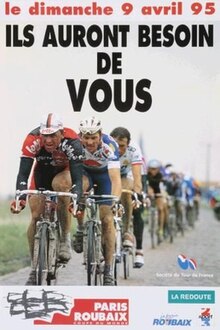1995 Paris–Roubaix
Today, 1995 Paris–Roubaix is a topic that arouses great interest and debate in society. Since its origins, 1995 Paris–Roubaix has captured the attention of people of all ages, cultures and contexts, becoming a frequent topic of conversation both professionally and personally. Over time, 1995 Paris–Roubaix has evolved in various ways and has acquired a relevant role in different aspects of daily life. Thus, it is essential to analyze and understand 1995 Paris–Roubaix in depth, its implications and its impact on today's society. In this article, we will delve into the world of 1995 Paris–Roubaix to address its many facets and offer a broad and enriching vision of this topic that is so relevant today.
| 1995 UCI Road World Cup, race 3 | |||||||||||||
|---|---|---|---|---|---|---|---|---|---|---|---|---|---|
 Official event poster | |||||||||||||
| Race details | |||||||||||||
| Dates | April 9, 1995 | ||||||||||||
| Stages | 1 | ||||||||||||
| Distance | 266.5 km (165.6 mi) | ||||||||||||
| Winning time | 6h 27' 08" | ||||||||||||
| Results | |||||||||||||
| |||||||||||||
The 93rd running of the Paris–Roubaix single-day cycling classic, often known as the Hell of the North, was held on 9 April 1995. Italian Franco Ballerini won his first of two victories, finishing two minutes ahead of the pursuing group after a 30 km solo. Andrei Tchmil won the sprint for second place before Johan Museeuw.[1] The race started in Compiègne and finished on the velodrome of Roubaix, overing a distance of 266.5 kilometres (165.6 miles). The race served as the third leg of the 1995 UCI World Cup. 91 of 178 riders finished.
Results
9-04-1995: Compiègne–Roubaix, 266 km.
| Cyclist | Team | Time | |
|---|---|---|---|
| 1 | Mapei–GB–Latexco | 6h 27' 08" | |
| 2 | Lotto–Isoglass | + 1' 56" | |
| 3 | Mapei–GB–Latexco | + 1' 56" | |
| 4 | Novell–Decca–Colnago | + 1' 56" | |
| 5 | Refin | + 1' 56" | |
| 6 | Brescialat–Fago | + 2' 00" | |
| 7 | MG Maglificio–Technogym | + 2' 00" | |
| 8 | Novell–Decca–Colnago | + 2' 00" | |
| 9 | Team Telekom | + 2' 00" | |
| 10 | Mapei–GB–Latexco | + 2' 00" |
References
- ^ a b "Paris-Roubaix, World Cup". Cyclingnews.com. Bath, UK: Future plc. 1995-04-09. Retrieved 2012-09-26.
External links
- Results by Cyclingbase.com Archived 2007-09-30 at the Wayback Machine